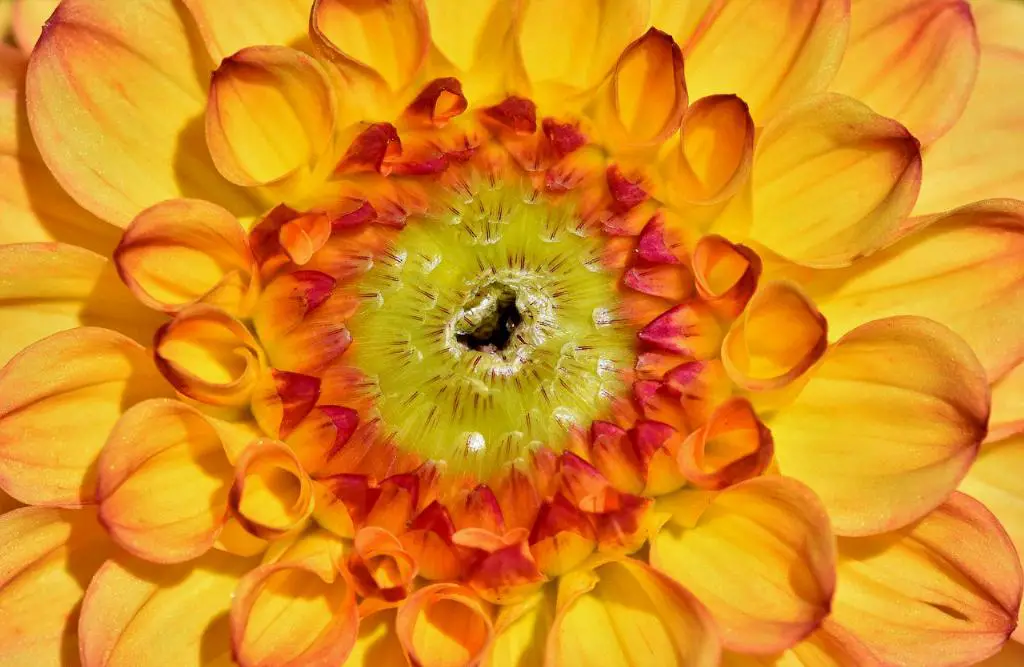Dahlia flowers stand out in the garden with their vivid colors and dynamic forms. Originating from the mountainous regions of Central America, dahlias bring a splash of variety with sizes ranging from dainty 2-inch lollipop-style pompons to the grand 12-inch “dinner plate” blooms. What truly sets them apart is their vast range of colors and the intricate petal patterns, which can captivate any flower enthusiast’s imagination. The versatility of dahlias extends beyond their beauty, as they are remarkably adaptable and can be cultivated in many different climates, though they thrive best in cooler conditions with well-drained soil.
The Various Types of Dahlias: From Pompons to Dinner Plates
Dahlias are celebrated for their diversity; each type brings its own unique qualities to a garden. The *Pompon* dahlias, with their spherical shape and tightly rolled petals, are perfect for creating a structured look. On the opposite end of the spectrum, the *Dinner Plate* dahlias offer show-stopping presence due to their large, dramatic blooms. Then there’s the *Cactus* variety, which dazzles with spiky, twisty petals that seem to defy the typical floral form. Understanding these types can help gardeners decide which will best suit their landscape aesthetic and space availability.
Essential Tips for Planting Dahlia Bulbs
To start your dahlia garden successfully, planting the tubers correctly is crucial. The ideal time to plant dahlias is in the late spring when the danger of frost has passed and the soil temperature has reached at least 60°F. Select a sunny spot as dahlias bloom best with 6 to 8 hours of direct sunlight daily. When planting, ensure the tubers are placed about 4 to 6 inches deep with the eye or the buds facing upwards. Space the plants about 2 to 3 feet apart to provide ample airflow, which helps minimize the risk of diseases.
Best Practices for Dahlia Care: Sunlight, Watering, and Soil Needs
For dahlias to really flourish, they need a bit of pampering with sunlight, water, and soil conditions tailored to their needs. They thrive in a location that receives full to partial sunlight. Watering should be consistent—dahlias enjoy a moderate amount of moisture but do not do well in waterlogged soil. Therefore, well-draining soil enriched with organic matter is ideal. Adding a layer of mulch can help retain moisture and regulate soil temperature, benefiting the overall health of the plants.
Pests and Diseases: Keeping Your Dahlias Healthy
Like many garden plants, dahlias are susceptible to certain pests and diseases. Aphids, spider mites, and slug attacks can be common, so regular inspections are necessary. For fungal diseases such as powdery mildew or botrytis, ensure good air circulation around plants and avoid overhead watering which can exacerbate these conditions. If pests or diseases appear, treat with appropriate fungicides or insecticides, or consider organic methods like neem oil which can be effective for both issues.
Pruning and Maintenance of Dahlia Plants
Pruning is vital for maintaining healthy, vibrant dahlias. By regularly deadheading spent flowers, you encourage the plants to focus their energy on producing new blooms. It’s also important to cut back the plants in late fall, after the first frost, as dahlias are tender perennials. This pruning helps to prevent fungal diseases, which can proliferate on dead foliage left over winter. For those in colder climates, don’t forget to dig up the tubers and store them in a frost-free place until spring rolls around again.
Designing Your Garden with Dahlias: Colorful Layout Ideas
Integrating dahlias into your garden design can transform your outdoor space into a vibrant tapestry of colors. For a stunning visual impact, consider planting dahlias in clusters or drifts based on color themes. You can create a warm-toned section with reds and oranges, or cool it down with purples and blues. Dahlias pair well with ornamental grasses or perennials that have a contrasting form or texture, thus enhancing the overall composition of your garden beds.
Dahlia Flower Meanings and Symbolism
Not only are dahlias beautiful, but they also carry rich meanings and symbolism. Traditionally, dahlias symbolize dignity and elegance but are also associated with commitment and an everlasting bond, making them perfect for celebrations of love and marriage. Each color of dahlia has its own unique significance, for instance, red dahlias represent power and strength while white can signify purity and focus. Planting dahlias can add not only color but also a layer of meaning to your garden. Isn’t that something special?
Celebrating Dahlias: Festivals and Shows Around the World
There are several dahlia festivals and shows across the globe, celebrating the diversity and beauty of these flowers. From the Seattle Dahlia Festival in the United States to the British National Dahlia Society Annual Show in the UK, these events gather enthusiasts and horticulturists alike, showcasing a myriad of varieties and floral arrangements. Attending one of these events can provide great inspiration for your gardening projects and a chance to connect with other dahlia aficionados.
Preserving Dahlia Flowers: From Drying to Pressing
When summer ends, you don’t have to say goodbye to your beloved dahlias. Preserving these flowers by drying or pressing is a great way to enjoy their beauty year-round. For drying, hang the flowers upside down in a dry, dark place until they are completely dehydrated. Pressing dahlias involves placing them between parchment paper and weighting them down for several weeks. Both methods capture the exquisite beauty of dahlias in forms that endure, allowing you to treasure or even gift them as keepsakes.

